As one of the fastest-rising ecommerce trends, voice search is certainly the hype these days. And as an ecommerce business owner, it’s something you cannot afford to lose out on.
But before launching into optimizing your ecommerce business for voice search, there are important voice search stats and facts you need to wrap your head around. You’ll need to know what voice search is, what the most popular devices that offer search by voice features are, where voice search is most popular, and more.
In this article, we present to you the ten most important voice search statistics you need to get your voice search efforts the kickstart it needs. Let’s dive in!
Post Contents
- 1. Voice Search Popularity in The United States
- 2. Voice Search More Popular Than Typing
- 3. Smart Speakers Ownership in The US
- 4. Smart Speakers Usage in The US
- 5. Smart Speakers Usage for Shopping
- 6. Role of Voice Search in Buyers’ Purchase Journey
- 7. Voice Ads Are More Engaging
- 8. Voice Search Statistics on Mobile Devices
- 9. Voice Search Engagement
- 10. Uses of Voice
- Conclusion
- Summary: Voice Search Statistics
- Want to Learn More?



1. Voice Search Popularity in The United States
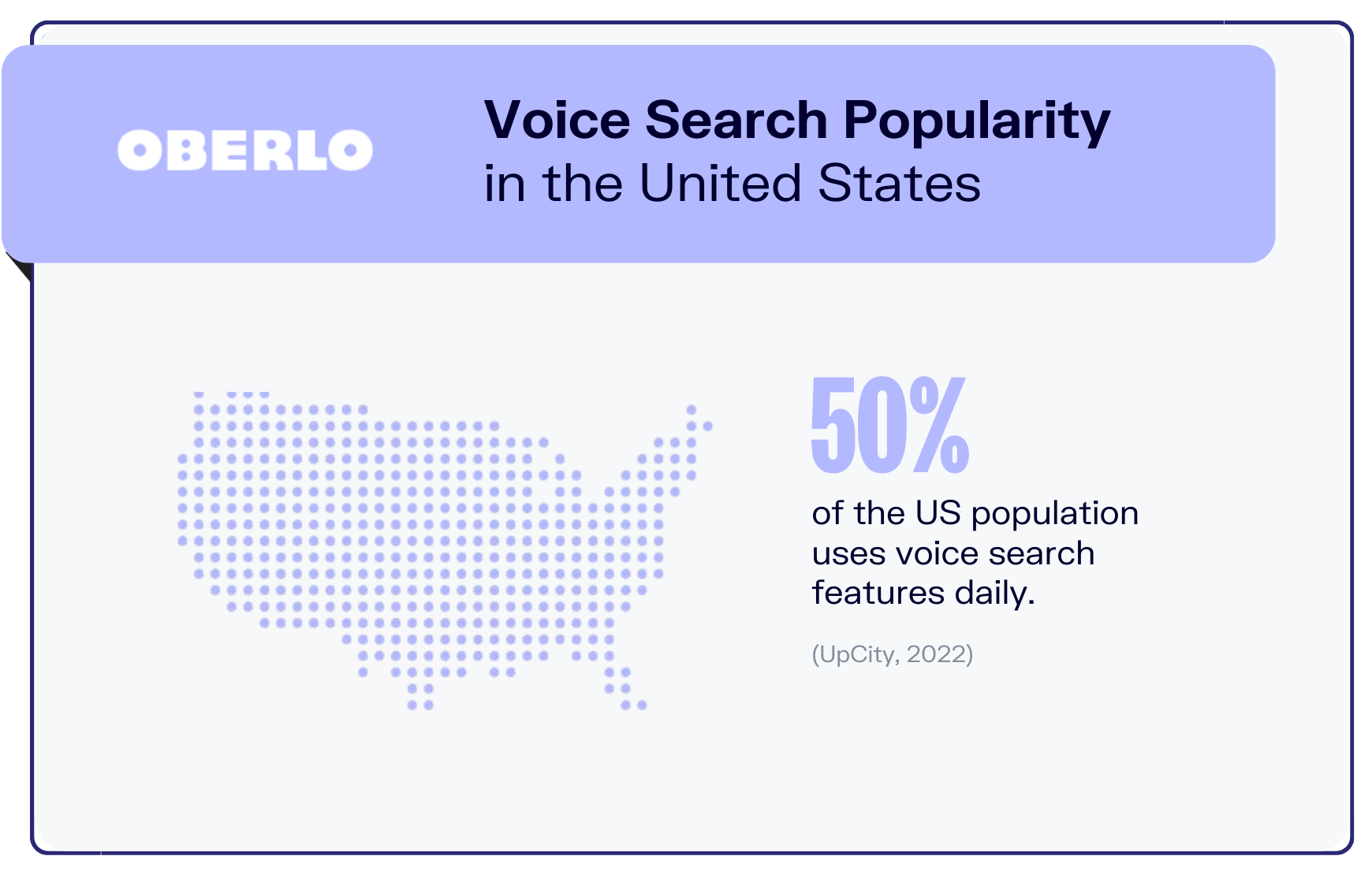
An increasing number of people in the United States are using voice to conduct searches. Recent reports estimate that currently, half of the US population uses voice search features daily, and more than one-third (34%) uses them at least once a week (UpCity, 2022).
→ Click Here to Launch Your Online Business with Shopify
The majority of voice search users are experienced users of its features, with nearly three out of every four (72 percent) of them having used it for between one to five years. In fact, as many as 16 percent say they’ve been relying on voice search for more than half a decade.
As we’ll explore in the next few voice search statistics, smartphones and smart speakers are currently the most popular devices among voice search users. But with other gadgets such as watches and wearables, TVs, and home appliances slowly offering voice search features, it may just be a matter of time before they become equally as popular – if not more.
2. Voice Search More Popular Than Typing
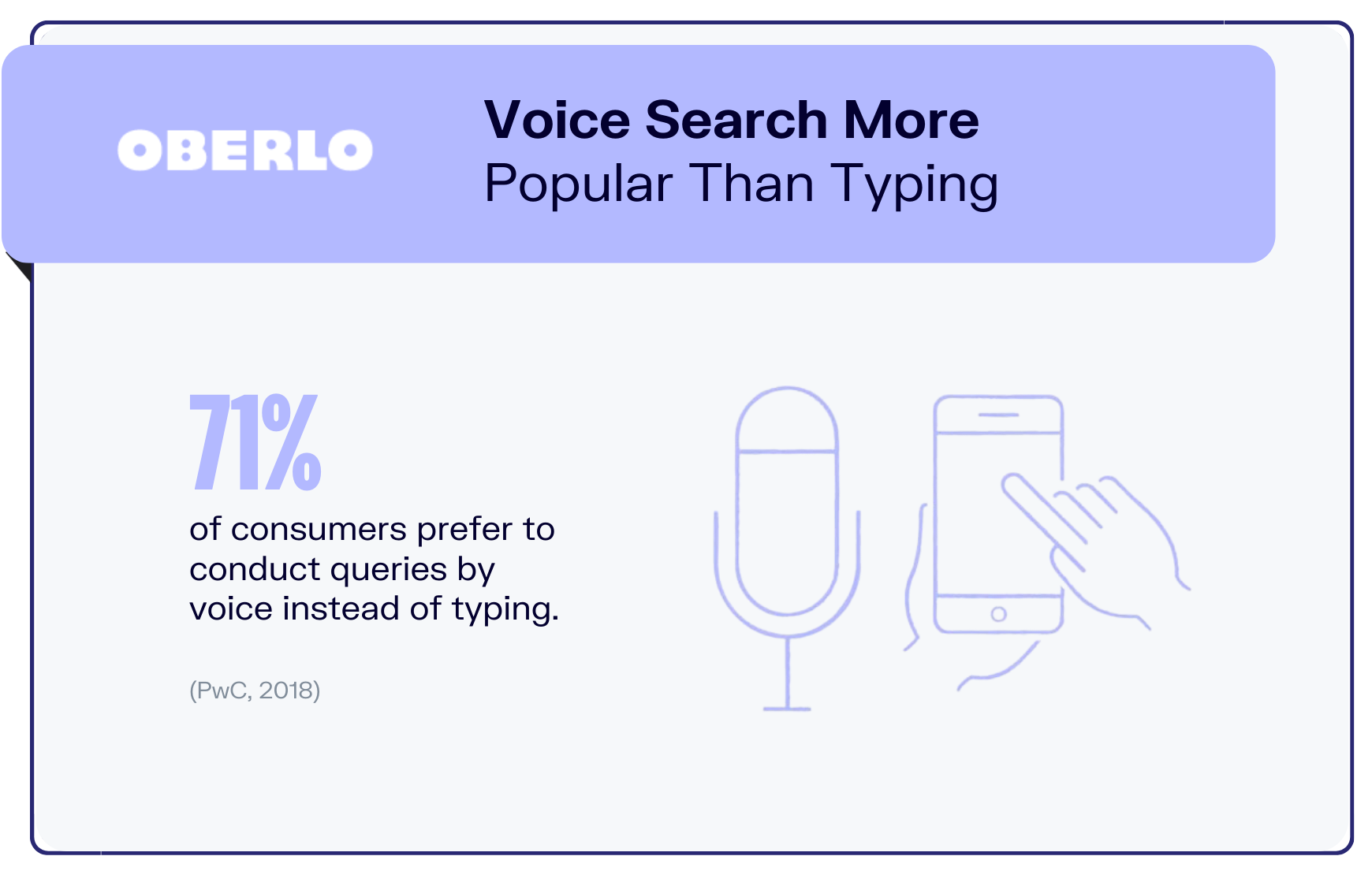
Nearly gone are the days of typing in a search query. Approximately seven out of ten consumers (71 percent) prefer to use voice searches to conduct a query over the traditional method of typing (PricewaterhouseCoopers, 2018).
Despite more advanced features voice search capabilities offer such as carrying out online purchases or controlling other smart home gadgets, its most popular usages remain restricted to more basic features. Conducting basic queries and information requests aside, users like to use voice searches to do basic tasks like check on the weather, play music, and set reminders.
But given the potential and benefits of voice search, it’s no wonder that it’s growing in popularity. This is particularly noteworthy for the disabled community and the visually impaired, who have benefitted from voice search as it allows them to bypass the inconvenient text-based functions.
3. Smart Speakers Ownership in The US
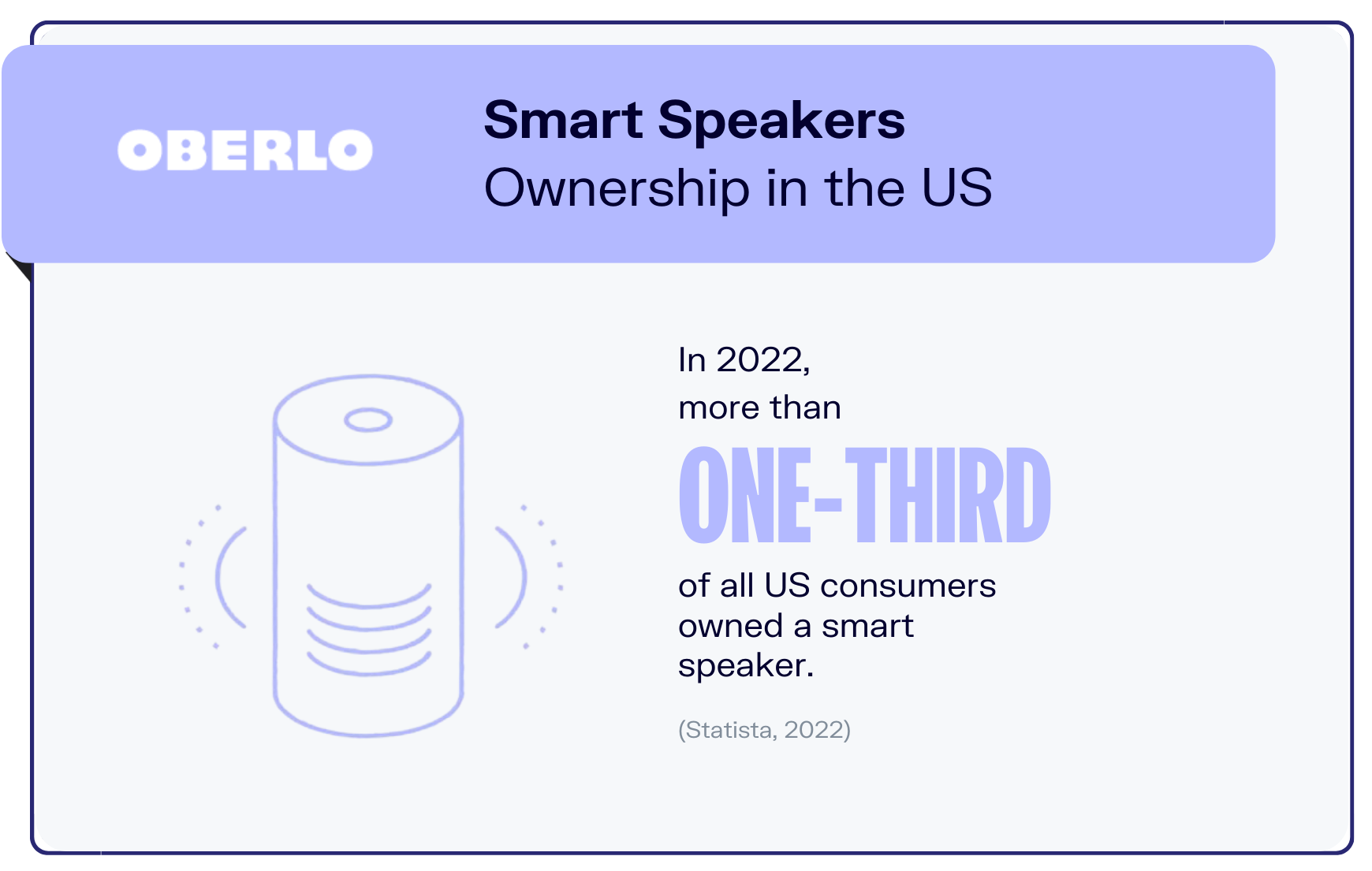
As of 2022, more than one in three (35 percent) US consumers possessed smart speakers (Statista, 2022). This marked a two percentage point annual increase and 11 percentage points over 2020, an indication of the growing popularity of these devices.
Recent data also shows that tech giants Amazon, Google, and Apple dominate the smart speaker market share in the US. With 94.2 million of its smart speakers in use, Amazon leads its competitors by a significant margin.
In comparison, 46.7 million people in the US own smart speakers by Google, which is fewer than half of Amazon. Statistics show, however, that the popularity of Google’s smart speakers has been rising quickly in recent years. Their sales grew a whopping 234 percent from 2019 to 2021. That being said, we can probably expect to see the gap between Amazon and Google narrow in the near future.
In third place, Apple’s smart speakers are owned by 10.8 million consumers in the US.
4. Smart Speakers Usage in The US
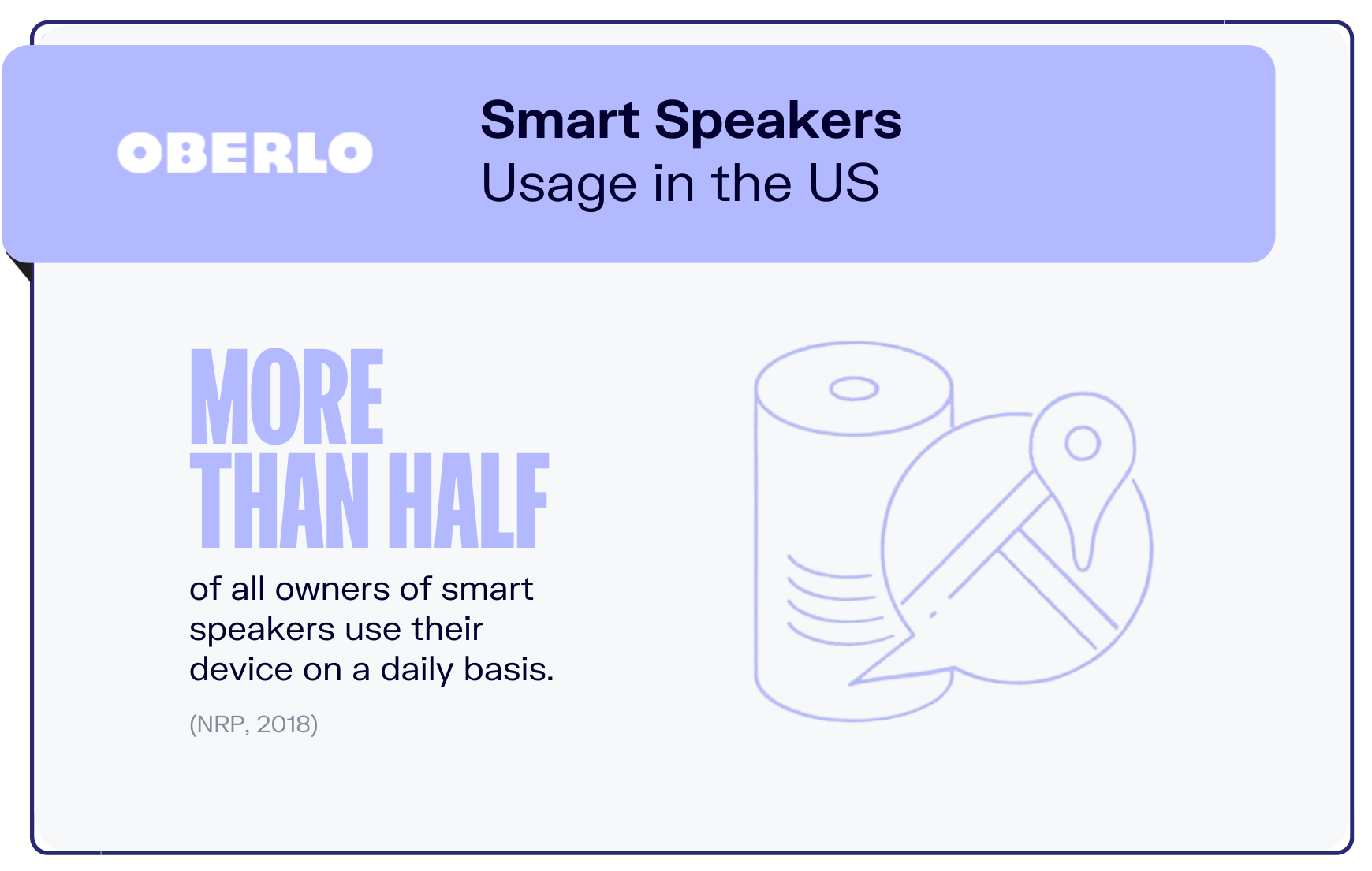
Ownership of smart speakers is on the rise, but so is voice search usage with smart speakers. 52 percent of all smart speaker owners use their devices daily (NPR, 2018). Over one-third use it to carry out voice searches.
Given the increasing use and popularity of smart speakers, if you happen to run an ecommerce business selling tech gadgets, consider amping up your marketing efforts around November. The period between Black Friday and the end of the year is proving to be a particularly popular time for purchases of smart speakers – eight percent of the US population bought a smart speaker during this period in 2018.
And depending on your target market, you may want to prioritize one brand over another. Just so you have an idea, Amazon currently holds about 70 percent of the smart speaker market share within the US, far outperforming its main rivals, Google Home and Apple’s HomePod.
5. Smart Speakers Usage for Shopping
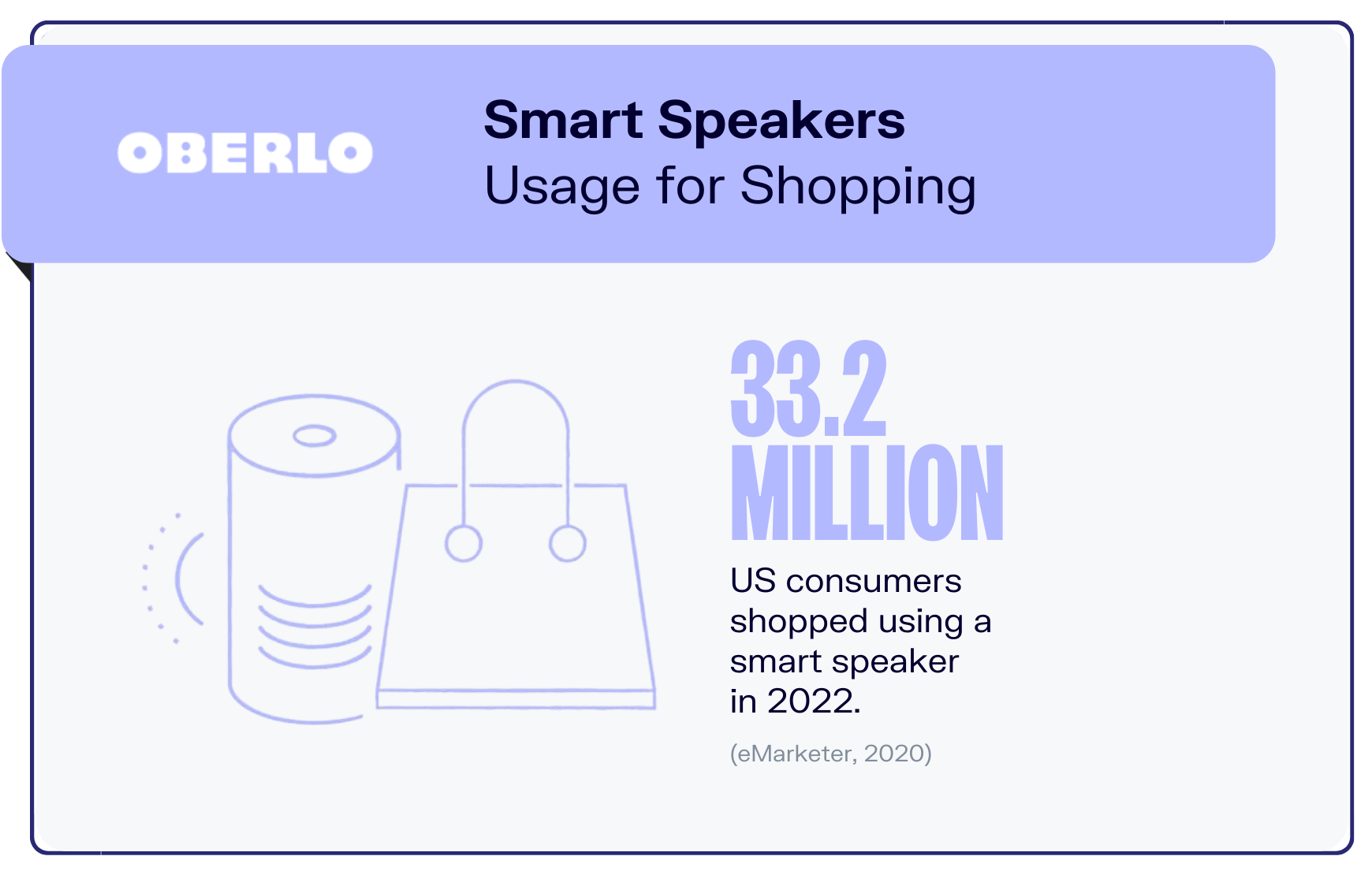
The rising ownership of smart speakers coupled with increasing ecommerce growth mean more and more people have started to turn to their smart speakers to shop online.
In fact, the latest research figures show that as many as 33.2 million consumers in the US were expected to shop using the voice search feature on their smart speakers in 2022 (eMarketer, 2020). To put things in perspective, this would represent a 3.5 percent growth from 2021’s 32.1 million, and 14.1 percent of the total number of digital shoppers in the US.
If you’re thinking about targeting consumers using smart speakers to shop, it’s important to know what they’re buying via voice.
Most purchases made via voice are for health and beauty products. In the period from August 2019 to August 2021, analysts estimate that as many as 8.9 million health and beauty products were bought via smart speakers. This is followed by the electronics category, which saw 8.8 million purchases.
Household supplies have also proven to be particularly popular items to be bought using smart speakers. Some 8.5 million household products were bought using voice during this period.
6. Role of Voice Search in Buyers’ Purchase Journey
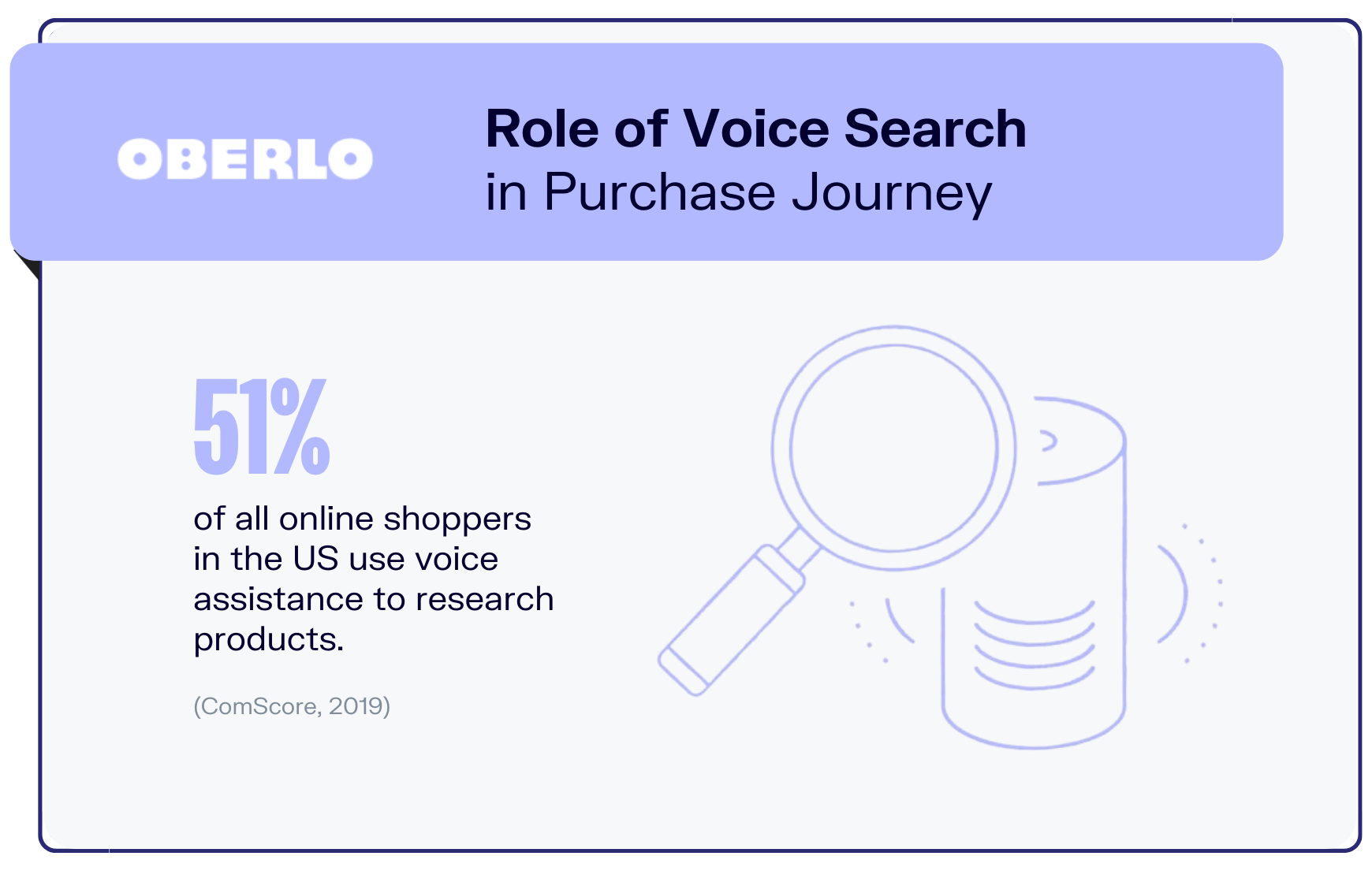
With more and more people opting to shop via voice search, it’s important to understand at which stage of the purchase funnel their dependence on voice search is the highest.
Survey results show that online shoppers use voice assistants more extensively in the pre-checkout stages than for checking out – particularly in product research and addition to shopping lists. More than half of all online shoppers in the US use voice assistants to help them research products, while over a third use them to add new items to their shopping lists (Narvar, 2018).
But it doesn’t just end there. Voice assistants continue to feature in the post-checkout stages, with 30 percent of online shoppers using it to track their packages, 20 percent leaving reviews or ratings, and 17 percent using voice search to repurchase items.
Considering the above-mentioned voice search statistics on shopping, as an ecommerce owner, you may want to consider optimizing your site for voice search!
7. Voice Ads Are More Engaging
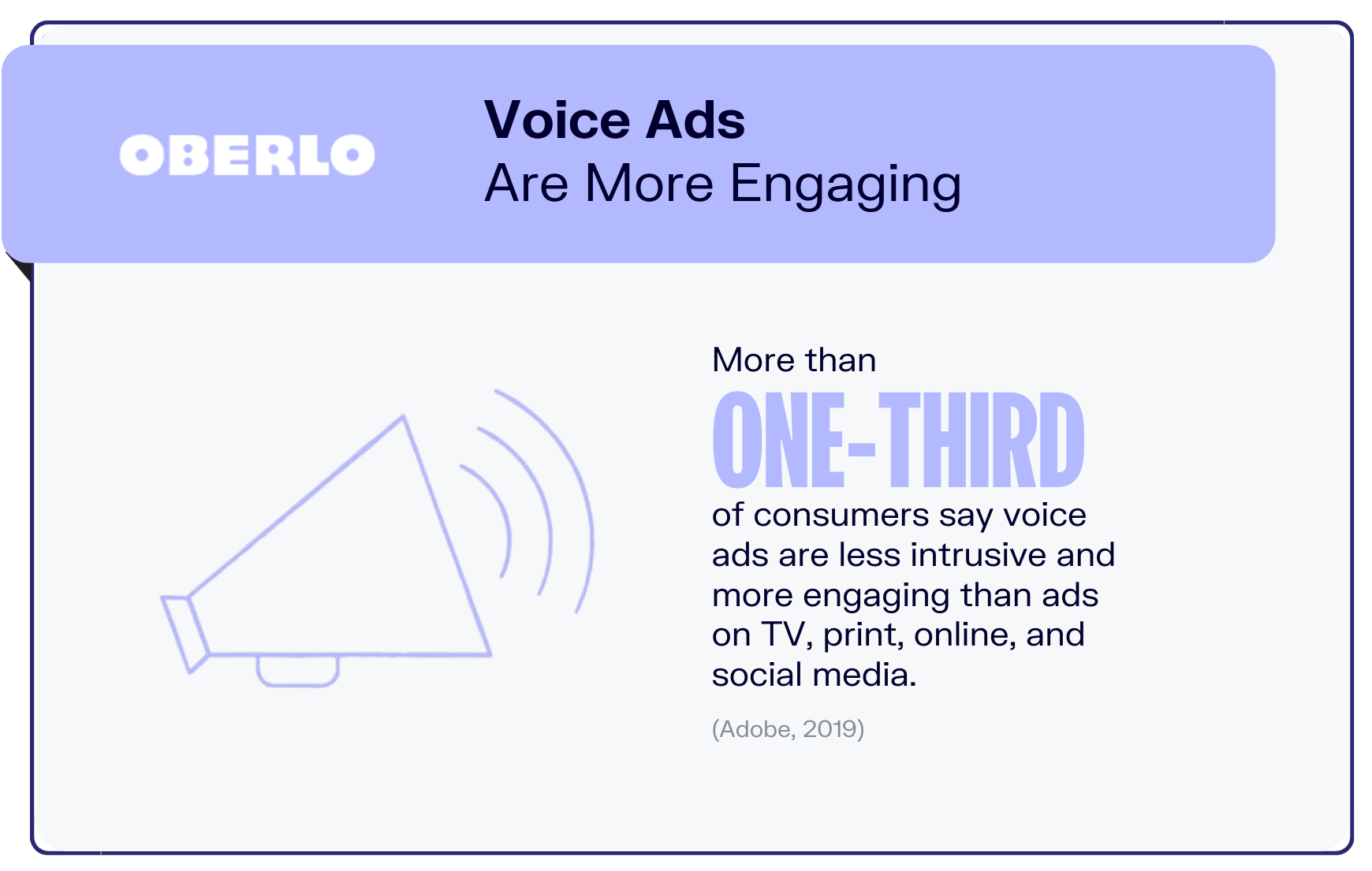
Just like all forms of media, ads also form a part of voice search. In fact, as many as one in four consumers say they have heard an ad on a smart speaker before.
But there is one thing that differentiates voice ads heard on smart speakers from other more conventional forms of advertising such as print, TV, online, and social media – consumers tend to be more accepting of voice ads.
The latest voice search statistics show that 38 percent of consumers who have heard voice ads on smart speakers find them to be less “intrusive” (Adobe, 2019). 39 percent also say they are more engaging.
According to experts, it’s because voice ads have the ability to resonate with consumers on a higher level emotionally and personally.
Not only do consumers relate better to voice ads, but they’re also responding better to them. Nearly 40 percent of people who heard a voice ad proceeded to purchase the item that was being advertised.
8. Voice Search Statistics on Mobile Devices
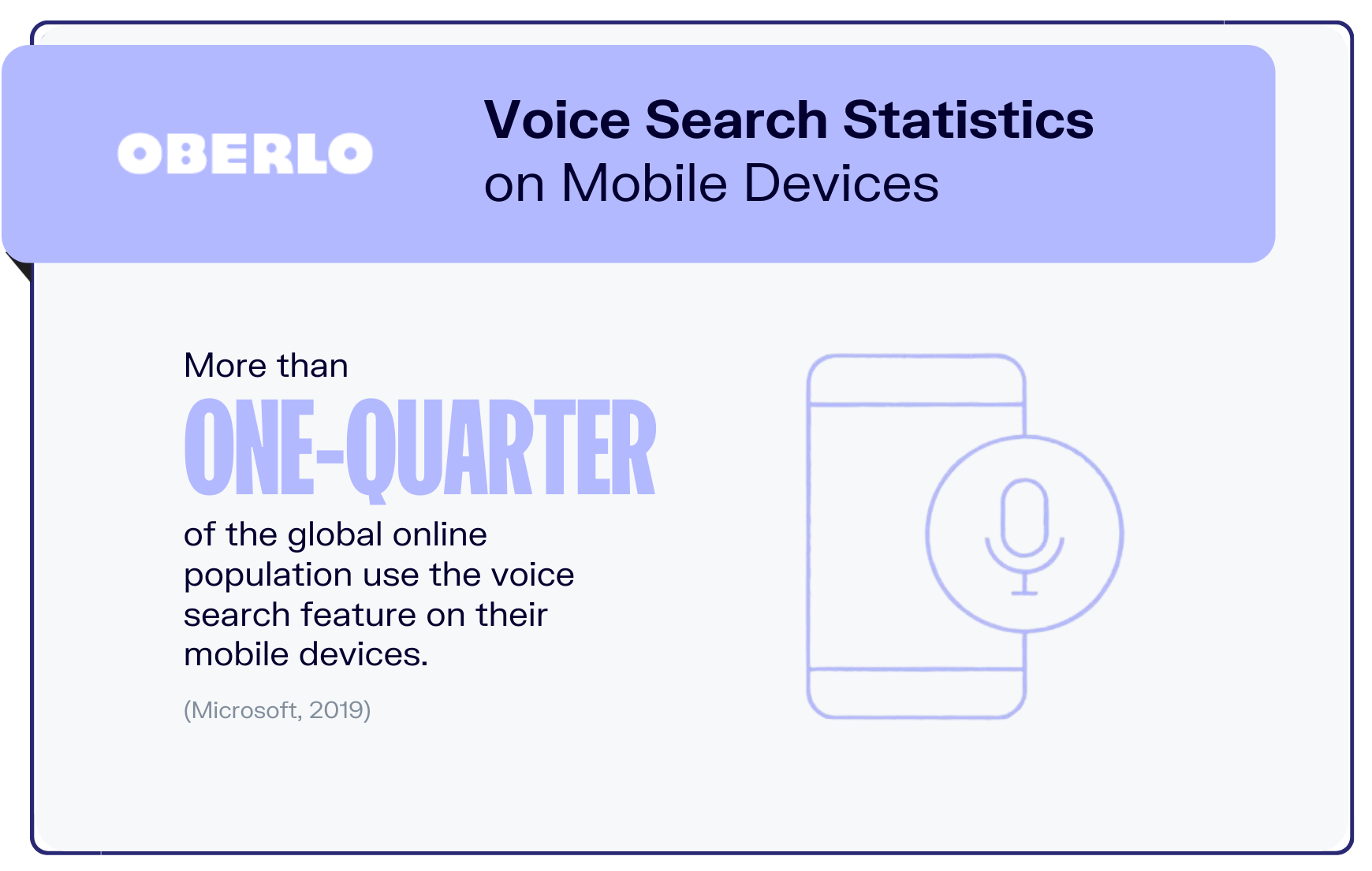
Currently, more than a quarter (27 percent) of the global online population is using the voice search feature on their mobile devices. (GlobalWebIndex, 2018) Usage is particularly popular among the 16-to-34 age bracket, with two-thirds of mobile voice search users falling into this particular age group.
If your ecommerce business targets both females and males, you’ll be happy to know that you may not need different strategies for these two gender groups as mobile voice search usage across both men and women are pretty even: 28 percent of men use voice-assisted searches on their mobile devices, compared to 26 percent of women.
In terms of markets, mobile voice search features are particularly popular among Asian countries. This is especially so in Indonesia, China, and India, where 38 percent, 36 percent, and 34 percent of all internet users reportedly carry out voice-assisted searches on their mobile gadgets. For comparison’s sake, just 25 percent of US internet users use the voice search feature on their mobile devices.
9. Voice Search Engagement
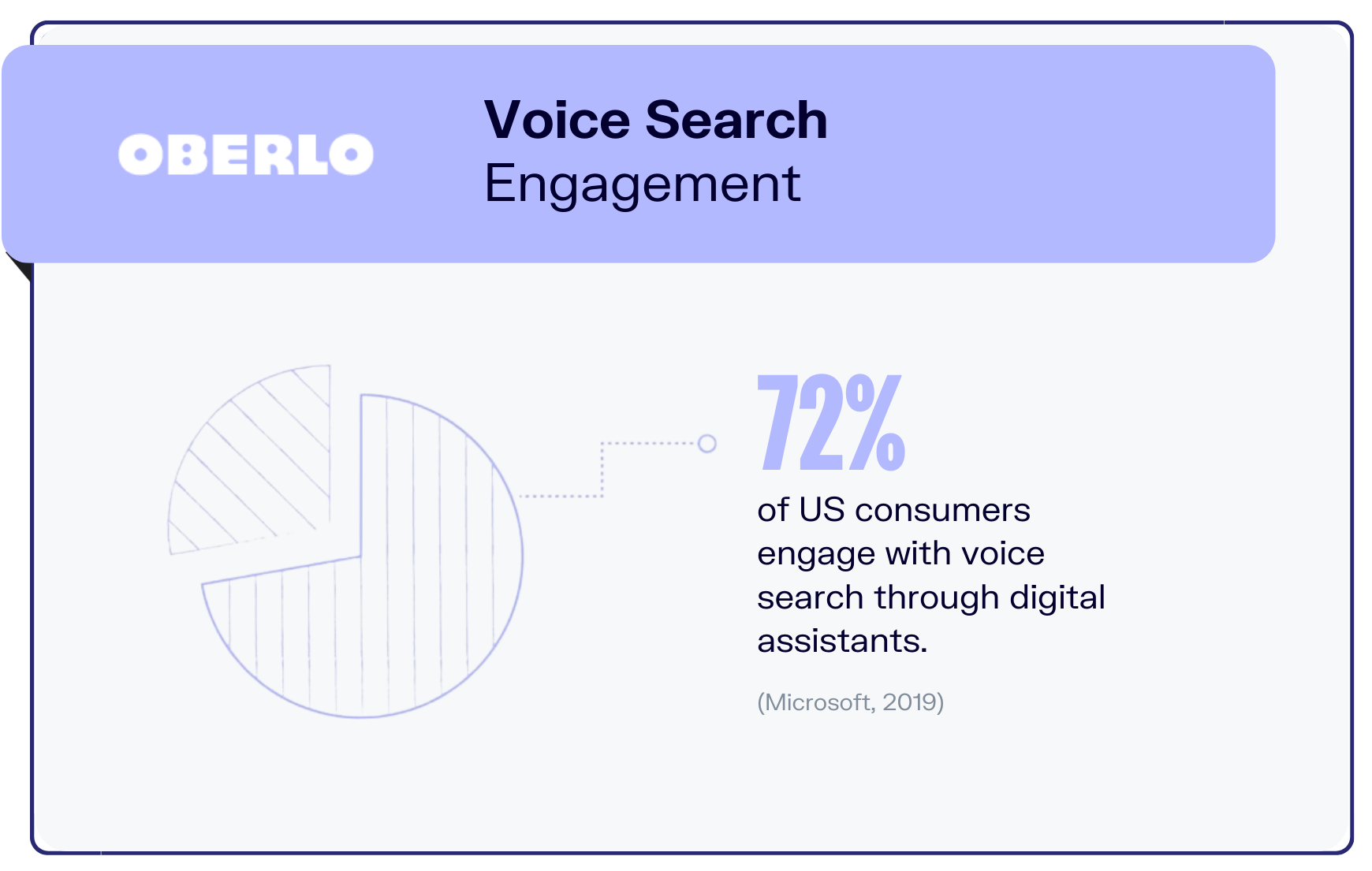
72 percent of US consumers are engaging with voice search through digital assistants such as Siri, Alexa, Google Assistant, and Cortana (Microsoft, 2018).
Of them, Google Assistant and Apple’s Siri are the two most popular digital assistants, with 36 percent of all US consumers reported to have used them for voice searches. This is followed by percent by Amazon’s Alexa and 19 percent by Microsoft’s Cortana.
Of all the gadgets available that offer voice-assisted search functions, smartphones appear to be the leading device of choice for voice search users. More than 90 percent of consumers report having used their smartphones to carry out voice searches, compared to less than half on their smart speakers and just over four in ten through in-car voice assistants.
10. Uses of Voice
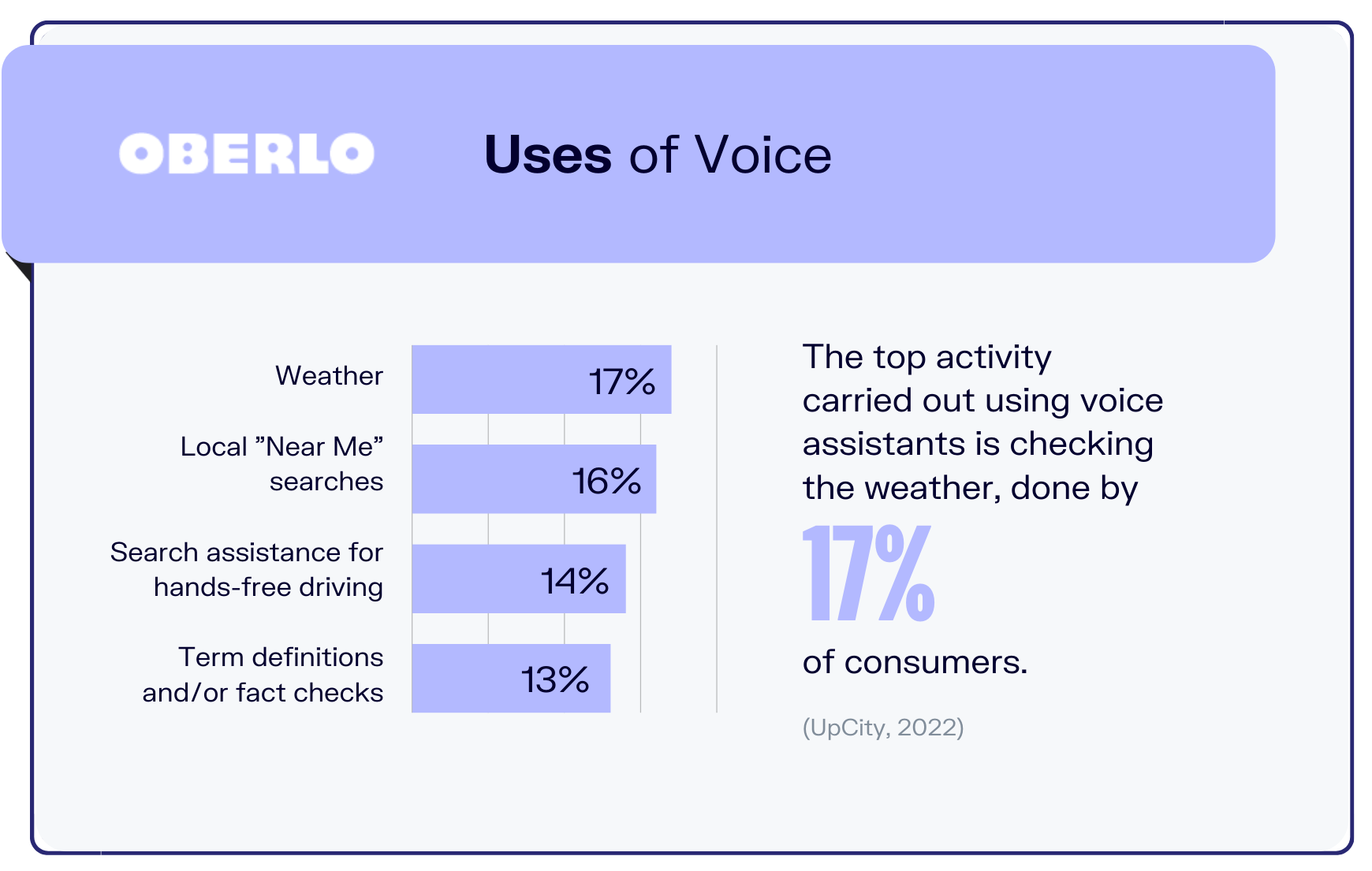
From the above voice search statistics, it’s clear that the technology is becoming increasingly popular and has the potential to revolutionize consumers’ daily lives.
But what are people using voice technology for?
According to a recent survey conducted on the use of voice search, the top task given to voice assistants by users is to check the weather, with around one in six (17 percent) users doing so (UpCity, 2022). This is followed by looking for nearby establishments such as restaurants and shops – carried out by 16 percent of voice search users.
14 percent also use voice assistants to conduct hands-free searches while driving, and 13 percent use them to look up definitions and facts. Looking for online products and services is also a popular use of voice search – a statistic ecommerce businesses should definitely be aware of.
Conclusion
Now that you’re equipped with ten useful voice search statistics, you can begin to use them to give your ecommerce business the boost it needs.
Whether you’re interested in optimizing your ecommerce page or boosting the sales and marketing strategy of your tech ecommerce store, these voice search stats will certainly come in handy to help understand the direction that ecommerce and mobile ecommerce are heading towards.

Summary: Voice Search Statistics
Here’s a summary of the Voice Search Statistics for 2023:
- 50 percent of the US population uses voice search features daily.
- 71 percent of consumers prefer to conduct queries by voice instead of typing.
- In 2022, more than one-third of all US consumers owned a smart speaker.
- More than half of all owners of smart speakers use their devices on a daily basis.
- 33.2 million US consumers are expected to shop using a smart speaker in 2022.
- 51 percent of all online shoppers in the US use voice assistants to help them research products.
- More than one-third of consumers say voice ads are less intrusive and more engaging than ads on TV, print, online, and social media.
- More than one-quarter of the global online population is using the voice search feature on their mobile devices.
- 72 percent of US consumers are engaging with voice search through digital assistants.
- The top activity carried out using voice assistants is checking the weather, done by 17 percent of consumers.



Want to Learn More?
- BigCommerce vs Shopify: Which One Is Better?
- How to Make Money on YouTube: 6 Effective Strategies
- 15 Pricing Strategies to Boost Your Sales (With Examples)
- 35 Small Business Ideas That’ll Make You Money
Is there anything else you’d like to know about voice search statistics and wish was included in this article? Let us know in the comments below!



